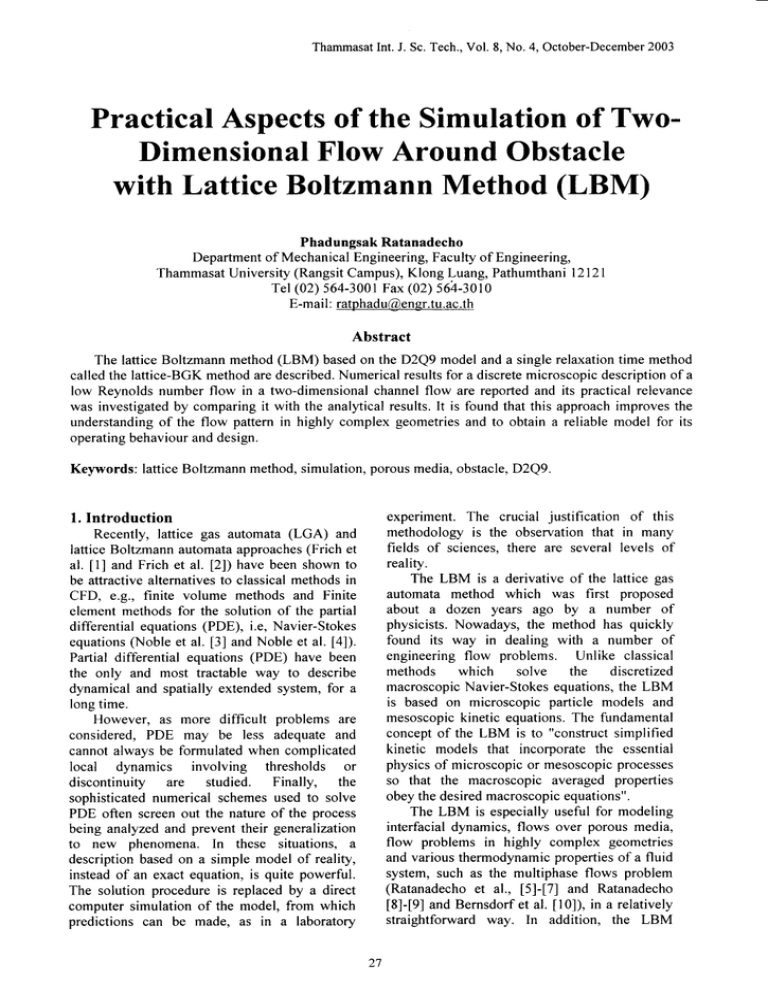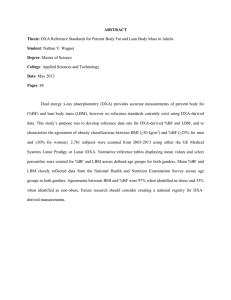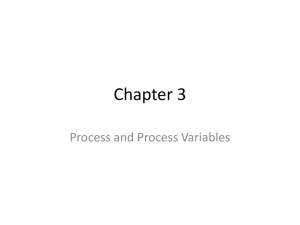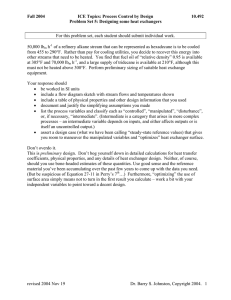Thammasat International Journal of Science and Technology
advertisement

2003
ThammasatInt. J. Sc. Tech..Vol. 8. No. 4. October-December
PracticalAspectsof the Simulationof TwoDimensionalFlow Around Obstacle
with Lattice BoltzmannMethod (LBM)
PhadungsakRatanadecho
Departmentof MechanicalEngineering,Facultyof Engineering,
ThammasatUniversity(RangsitCampus),Klong Luang,Pathumthani12121
Tel (02) 564-3001Fax (02) 564-3010
E-mail: ratphadu@engr.tu.ac.th
Abstract
The latticeBoltzmannmethod(LBM) basedon the D2Q9 model and a singlerelaxationtime method
calledthe lattice-BGK methodare described.Numericalresultsfor a discretemicroscopicdescriptionof a
low Reynoldsnumber flow in a two-dimensionalchannelflow are reportedand its practicalrelevance
was investigatedby comparingit with the analyticalresults.It is found that this approachimprovesthe
understandingof the flow pattern in highly complex geometriesand to obtain a reliable model for its
operatingbehaviourand design.
Keywords: latticeBoltzmannmethod,simulation,porousmedia,obstacle,D2Q9.
experiment. The crucial justification of this
methodology is the observationthat in many
fields of sciences,there are several levels of
reality.
The LBM is a derivative of the lattice gas
automata method which was first proposed
about a dozen years ago by a number of
physicists.Nowadays, the method has quickly
found its way in dealing with a number of
engineeringflow problems. Unlike classical
methods which
discretized
solve the
macroscopicNavier-Stokesequations,the LBM
is based on microscopic particle models and
mesoscopickinetic equations.The fundamental
conceptof the LBM is to "constructsimplified
kinetic models that incorporate the essential
processes
physicsof microscopicor mesoscopic
so that the macroscopic averaged properties
obey the desiredmacroscopicequations".
The LBM is especiallyuseful for modeling
interfacialdynamics,flows over porous media,
flow problems in highly complex geometries
and variousthermodynamicpropertiesof a fluid
system,such as the multiphaseflows problem
(Ratanadechoet al., [5]-[7] and Ratanadecho
[8]-[9] and Bernsdorfetal. [10]), in a relatively
straightforward way. In addition, the LBM
1. Introduction
Recently, lattice gas automata (LGA) and
latticeBoltzmannautomataapproaches(Frich et
al. [1] and Frich et al. l2l) have been shown to
be attractivealternativesto classicalmethodsin
CFD, e.g., finite volume methods and Finite
elementmethodsfor the solution of the partial
differential equations(PDE), i.e, Navier-Stokes
equations(Noble et al. [3] and Noble et al. [4]).
Panial differential equations(PDE) have been
the only and most tractable way to describe
dynamical and spatially extendedsystem,for a
longtime.
However, as more difficult problems are
considered, PDE may be less adequateand
cannot always be formulatedwhen complicated
local dynamics involving thresholds or
discontinuity are studied. Finally, the
sophisticatednumerical schemesused to solve
PDE often screen out the nature of the process
being analyzedand preventtheir generalization
to new phenomena. In these situations, a
descriptionbasedon a simple model of reality,
insteadof an exact equation,is quite powerful.
The solution procedureis replacedby a direct
computer simulation of the model, from which
predictions can be made, as in a laboratory
27
2003
4, October-December
algorithm tends to be very simple, allowing
parallelismin a straightforwardmanner.
The objectiveof the study is to developan
algorithm based on lattice- Boltzmann (BGK)
automata(Qian et al. I l]) to investigatea twodimension flow around an arbitrary obstacle
mounted in a channel for a range of Reynolds
numbersbetween80 and 300 as well as flow
around a highly complex obstacle.In order to
check the accuracy,the calculationsfrom the
present LBM model are comparedwith the
theoreticalresult for the single phasechannel
flow problem.
2. Description of Numerical Method
The concept of LBM treats the fluid on a
statisticallevel, simulatingthe movementand
interactionof single particles or ensembleaveraged particle density distributions by
solving a velocity discrete Boltzmann-type
equation. The lattice-Boltzmannmethod has
been shown to be a very efficient tool for flow
simulation in highly complex geometries
by up to severalmillion grid points.
discretized
For the present computation, a 2D ninespeed(D2Q9) lattice-Boltzmannautomatawith
(Bhatnagar
single time Bhatnagar-Gross-Krook
et al. [12]) relaxationcollision operatorA;Boi''
p r o p o s e bd y Q a i ne t a l . [ 1 1 ] i s u s e d :
f , ( t .* t , 7+. i ) = . f , ( t . , i ) +g ' "
(r)
Ll""'=r(f"" -.f,)
Q)
with a localequilibriumdistributionfunction
1y'i"q
:
[
" ,,
uul " "
",)l
f ; q t , o ] t '' ,# - : :- ' l, # - u
.-\
t
\
rl
(3)
/t
This local equilibriumdistributionfunction
.f,"' has to be computed every time step for
2.1 Numerical schemes
All numericalsimulationspresentedin this
paper will be briefly described here. For
simplicity, an equidistantorthogonallattice is
chosen for common LBM computation.This
could be done without a significant loss of
memory and performance,since the LBM
requiresrnuchlessmemoryand CPU time than
every node from the componentsof the local
flow velocitiesuo and up, thefluid densityp , a
lattice geometry weighting factor /, and the
speedof soundc,, which we choseto recover
the incompressibletime-dependentNavierS t o k e se q u a t i o n(sQ i a ne t a l . [ 1 1 ] ) :
classicalmethods.On every lafticenode r- , a
set of i real numbers, the particle density
distributions/ , is stored. The updating of the
A,p+6"4*")=0
fattice basically consists of two steps: a
streamingprocess,where the particle densities
are shiftedin discretetime stepsd throughthe
latticealongthe connectionlinesin directionc, ,
to their next neighboringnodes/, +c, - and a
relaxation step, where locally a new particle
distribution is computed by evaluating an
equivalentto the Boltzmanncollision integrals
( 4,o""'). For every time step, all quantities
appearing in the Navier-Stokes equations
(density, velocity, pressure gradient and
viscosity)can locally be computedin terms of
simplefunctionsof this densitydistributionand
(for the viscosity)of the relaxationparametero.
28
a,(pr"y+ar(ou"uu)=
-au,+ pa
or. + 0"u,,)
1t(a
(4)
(5)
In addition, the left side of Eq. (l) is
stagein LBM, and
to the "translation"
analogous
"collision"stage.For example,in
the right to the
"D2Q9" model,thereare 9
the two-dimensional
velocities1 i, ; on a square lattice: one has
"rest" particle;
speed:Oand correspondsto a
a
t
0
,
9
0 , 1 8 0a n d2 7 0
a
r
e
f o u r h a v es p e e d - la n d
degrees;and four have speed:Ji at 45, 135,
as shownin Fig. l.
225 and315 degrees,
ThammasatInt. J. Sc. Tech.,Vol. 8. No. 4. October-December
2003
KK#
ffiffi'ffi,
Fig.l
Schematic 2D lattice Boltzmann
calculation on a square lattice, after the
translationstep. Shown are 6 fluid sites and 3
wall sites (the wall is shown with a brick
pattern).
the lattice-Boltzmannequation is of second
order,thesebounce-backconditionsare the most
efficient ones for arbitrary complex geometries.
Furthermore, previous investigations showed
that the error produced by the bounce-back
boundaryconditions is sufficiently small if the
relaxation parameterar is close enough to 2.
Therefore, we believe that the bounce-back
conditions can still be used without any
influenceon the order of the LBM scheme,if at
is chosen within a suitablerange.Furtherrnore,
the bounce-backboundary conditions are the
most efficient ones for arbitrary complex
geometries, which are most typical for the
applicationof LBM.
Inlet and outlet boundary conditions
In order to simulate a fully developed
laminar channel flow, a parabolic velocity
profile with a maximum velocity u_
is
prescribedat the channel inlet whereas fixed
pressureoutlet boundaryconditionsare chosen.
Through careful choice of the equilibrium
distribution,the macroscopicquantities(density,
velocity, pressure gradient and viscosity)
fulfilling the Navier-Stokes equation can be
obtainedin terms of the momentsof the particle
d i s t r i b u t i o nf u n c t i o n" f , ( t . r ) a t e a c h s i t e . e . g .
for the D2Q9 model:
Inilial boundary conditions
For the validationtest cases,the equilibrium
distribution function f,"q was computed from
given velocity fields for uniform pressure
distributionand taken as the initial solirtion for
the density distribution function I . The flow
field for the arbitraryobstacleis initialized with
Densify:
y=)
l,(r.tl
(6)
f,(r-t)c,l p
(7)
t
/-/J
F l o w v e f o c i t y u' = )
/
\
the equilibrium distribution function f,"q for
zero velocity and uniform pressure,and the inlet
velocity had slowly been increasedduring the
first few thousand iterations, to avoid the
generationof pressurewaves.
l
Pressure:
p = pc:
1 ( )
Viscosity:,=il;-r)
(8)
\
(e)
2.2Boundaryconditions
Llall boundary conditions
Thereis a long and still ongoingdiscussion
on the properuseof boundaryconditionswithin
the frameworkof LBM. Although it is known
that simple bounce-back wall boundary
conditions are of first-order accuracywhereas
29
3. Result and Discussion
In order to check the accuracy, the
calculations from present LBM model are
compared with the theoretical result for the
single phasechannelflow problem.Comparison
of the velocity profile in Fig. 2 showsthe same
trend although the spatial variation of the
velocity profile near the center of channel
predictedby our model is slightly higher than
the theoreticalresult. This might be due to the
initializationof the densitieswith equilibrium
distribution f,"q because of lower iteration
numbers.
2003
Int.J. Sc.Tech.,Vol. 8, No. 4, October-December
Thammasat
are positioned vertically centered in the first
third section of the computational domain with
sizes betweenI x h = 500 x 80 and / x h = 2000
x 320 latticeunits.
-.-..
.r...t'
/,'/'
- < "
"it'
a'
]
l
---- ---
"
o'
'
-
I
l
Fig. 3 Obstacleof sized x x in channelof size
lxh
Fig.2 Singlephasechannelflow
For the wall, a no-slip boundarycondition is
realized by particle density bounce-back. A
parabolicvelocity inflow profile is applied,and
the outlet pressureis fixed.
The only quantity taken into account in the
present analysis is the Strouhal number St,
computed from the obstacle diameter d , the
measured frequency of the wakes / and the
maximumvelocity umd, as definedin Eq. (l l):
The good results for the above test case
clearly show the possibility of performing
accuratenumericalsimulationfor various single
phase channel flow problem with the present
implementation of the lattice Boltzmann
method. Especially, as is already known from
the latticeBoltzmanntheory,wherethis quantity
could be taken into account for a proper
definition of viscosity, no problems with the
numericaldissipationhavebeenobserved.
st= fd
3.1 Flow around a square obstacle
The flow around a square obstacle
positionedinside a channelwas simulatedfor a
range of Reynoldsnumber Re between80 and
300, definedby the lengthofthe obstacled,the
maximum flow velocity lt-*of the parabolic
All computationsare done on one processor
of the Pentium III. Starting with zero flow
velocity and uniform pressure,after a sufficient
number of iterations, time-dependent flow
evolves with a fixed frequencyl This frequency
;f was determined by spectral analysis of the
temporal evolution of the v-component of the
flow velocity at several points in the wake
behindthe obstacle.
For this quantity, the numerical convergence
of the schemewith respectto grid resolutionwas
investigated first. What is known from fluid
mechanics,and can be reproducedvery well by
our simulations(see Fig.4), is the fact that the
topology ofthe vortex sheddingbehind a square
obstaclechangessignificantly with the Reynolds
number. For a Reynolds number of 80 the
separationpoint of the vorticesis observedto be
the rear edge of the obstacle, whereas it moves
from the rear to the front edge ofthe obstaclefor
higher Reynolds numbers.At Re = 266, small
secondaryvortices can be found at the top and
inflow profile and the dynamicviscosity v as:
F(e=u^*d
(11)
u^o
(10)
v
In this region, it is known from experiments
and other numericalstudiesthat vortex shedding
is observed and a two-dimensional time
dependentflow evolves.At a Reynoldsnumber
Re above approximately 300, the flow might
and two-dimensional
becomethree-dimensional,
computations will therefore not produce
physicalresults.
According to the computationaldomain as
shown in Fig. 3, obstaclesof sizesrangingfrom
d x d : l0 x 10 up to dx d = 40 x40 latticeunits
30
2003
Int.J. Sc.Tech.,Vol. 8, No. 4, October-December
Thammasat
For one full period, the streamlinesof a
sheddingvortex are shown in Fig.6 at Re : 80.
One can see a small vortex developing at the
rear top edge of the squareobstacle,which is
moving downwardswhile growing, and moves
upwards while growing, to separatefinally from
the top rear edgeofthe obstacle.
bottom ofthe obstacle.A sufficientresolutiono1
this secondary vortex appearsto be crucial for
the developmentofa correctsheddingfrequency
f, which results in the necessityfor finer grids
for higher Reynoldsnumbers.
The dependenceof the Strouhalnumber St
on grid resolution can be seen for Reynolds
numbers between 80 and 266 in Fig.5. The
values indicatesecond-orderconvergenceof the
scheme,and lattice sizesof I x h : 2000 x 320
for obstaclesof dimension d : 40 product
results with good accuracy for Reynolds
numbers up to 300. For Reynolds numbers <
100, near dependenceof Strouhal number on
grid resolution can be observed, which is in
accordancewith our observationsconcerning
secondaryvortices.
0.15!
ot16
lD
E
Ia o.r*
'.
A
..
ORcoe
€!n . tti
9p.Al0
ai|?. Zt6
t'-.'--.-'-.-€l
,c..
6
€p ors
6
- ! - . - l - $
ll-j:r..,:g-O . - - . _ _- - _ _ - o - - - .
le
_- - _ - - _ - €
'--- ---- -a
l!00
Lattice x-Size
Fig.5 StrouhalnumberSt as a function of linear
lattice dimension I for different Reynolds
Number Re
3.2 Flow around a highly complex obstacle
For practical applications, this simple
procedureas explained in the previous section
allows for an easy implementationof arbitrary
complex. structures (e.g. the flow simulation
through a porous structureas presentedin Fig.
7).or to changethe obstaclestructureduring the
computation,which is necessaryfor problems
with time varying flow geometry.To illustrate
the capabilitiesof LBM, the flow contoursand
velocity vector fields during fluid flow througha
highly complexporousstructureare presentedin
Fig. 8. It is evident from the figure thal
regardlessof the complexity of the pores, the
flow features expected are well captured by
using LBM simulation.
(a)
4. Conclusion
With two classicalflow studies,this paperis
able to show that our implementationof the
lattice BGK automatayields reliable resultsfor
time-dependentflows. Strouhal numbers St for
two-dimensionalchannelflows around a square
obstaclewith a blockageratio of b = 0.125 and
Reynolds numbers between 80 and 300 are
measurednumerically. It is shown that for a
correctevaluationofthe Strouhalnumberhigher
(b)
Fig.4 Flow around a square obstacle at (a)
Re=80 and (b) Re=266,for the higher Reynolds
number,secondaryvorticesaboveand below the
squareobstacleare displayed
3l
ThammasatInt. J. Sc. Tech..Vol 8, No. 4, October-December
2003
grid resolutions are necessary for higher
Reynolds numbers owing to the generationof
small secondaryvortices below and above the
obstacle,which haveto be resolvednumerically.
In addition,concerningcomplexgeometries,
the CPU time for the LBM first decreasedwith
increasingcomplexity of the obstaclestructure
(e.g. the flow simulation through a porous
structure as presentedin Fig. 8) and become
almost independentfrom it for highly complex
h)
{e)
)z
structures. In summary, the LBM method
strengthensthe often stressedopinion that this
method is competitive with respect to the
applicationof CFD especially for problems
involving complex geometriessuch as porous
media.
The next step in researchin this area is to
measurethe performanceof LBM model against
exoeriment.
ThammasatInt. J. Sc. Tech..Vol. 8. No. 4. October-December
2003
ts)
Fig.6 One periodof vortexsheddingbehinda squareobstacleat R*80
33
2003
Int.J. Sc.Tech.,Vol. 8, No. 4, October-December
Thammasat
Ernrnr -+
ffi@l
+ffiffi
I
rLUUU
+
.
------F
FLOW +
-+
EEEE
Esss
EEEE
E EEE
a
a
r
t
r
t
|
t
a
a
a
I
! r
r r !
a t !
t a !
t r r
r !
! a a !
! ! l
! ! l
! ! a
a ! a
i ! a !
Fig. 7 Obstaclestructurewith increasingcomplexity
u conbut3
x
Fig. 8 Flow through2D porousmedia
34
U
trDal
SDII
trDID
AD}+
D.DI7
[Dl I
hD54
AtrT7
BF{I
trDS
60?t
[Dtl
[0 t5
ADD'
[004
2003
ThammasatInt. J. Sc. Tech.,Vol. 8, No. 4, October-December
5. Acknowledgment
This work was supported by the
Department of Chemical Engineering &
Materials Science University of Minnesota,
Twin Cities underPostDoctoral Grant.
6. References
tll Frisch, U., d'Humieres,D., Hasslacher,
B., Lallemand,P., Pomeau,Y. and Rivet,
J.P., Lattice Gas Hydrodynamicsin Two
and Three Dimension,Complex Systems
1, pp. 649-701, 1987.
Frisch,
U.; Hasslacher,B. and Pomeau,
[2]
Y.,Lattice-GasAutomata for the NavierStokesEquation,Phys. Rev. Lett. 56, pp.
r505-1508,1986.
[3] Noble, D.R.; Georgiadis, J.G. and
Buckius. R.O.. Direct Assessmentof
Lattice Boltzmann Hydrodynamics and
Boundary Conditions for Recirculating
F l o w s ,J . S t a t .P h y s .8 1 , p p . l 7 - 3 3 , 1 9 9 5 .
[4] Noble, D.R.; Georgiadis, J.G. and
Buckius, R.O., Comparisonof Accuracy
for Lattice Boltzmann and Finite
Difference Simulationsof SteadyViscous
Flow. Int. J. NumericalMeth. Fluids 23,
p p .1 - 1 8 , 1 9 9 6 .
[5] PhadungsakRatanadech,Aoki , K. and
A
Numerical and
Akahori. M..
the
Experimental Investigation of
Modeling of Microwave Drying Using a
Rectangular Wave Guide, J. Drying
Technology,Vol. l9(9), 2001, pp.2209'
2234
[6] PhadungsakRatanadech,Aoki , K. and
Akahori, M., Experimentaland Numerical
Study of Microwave Drying in Unsaturated
J.)
Porous Material, Int. Commun. Heat Mass
Transfer,Vol.28 (5), pp. 605-616.2001.
[7] Phadungsak Ratanadech, Aoki , K. and
Akahori, M., Influenceof IrradiationTime,
Particle Sizes and Initial Moisture Content
During Microwave Drying of MultiLayeredCapillary PorousMaterials,ASME
J. HeatTransfer,Yol. 124(l), pp. 151-161,
2002.
Phadungsak
Ratanadecho, Experimental
[8]
and Numerical Study of Solidification
Process in Unsaturated Granular Packed
Bed, AIAA J. Thermophysicsand Heat
Transfer,Vol. I 8( 1), 2004.
[9] PhadungsakRatanadecho,The Numerical
and Experiment Investigation of Heat
Water Infiltration in
Transport and
Granular Packed Bed due to Supplying
Hot Water (One- and -Two Dimensional
Models), ASCE EngineeringMechanicsJ.
(to be published),2004.
Schiifer,
J.
and
[0] Bernsdorf,
M.,Comparisonof Cellular Automata and
Finite Volume Techniquesfor Simulation
of IncompressibleFlow in PorousMedia,
ERCOFTAC Bulletin 28, pp. 24-21,
1996.
Y.H.; d'Humidres, D. and
Qian,
[11]
Lallemand,P., Lattice BGK Models for
Navier-StokesEquation, Europhys. Lett.
17 (6 BIS), pp.479-484,1992.
P.L., Gross, E.P. and Krook,
Bhatnager,
[12]
M., A model for Collision in Gases. I.
Small Amplitude Processesin Charged
and Natural One-Component System,
Physical Review, 94(3), pp. 411-525,
1954.





